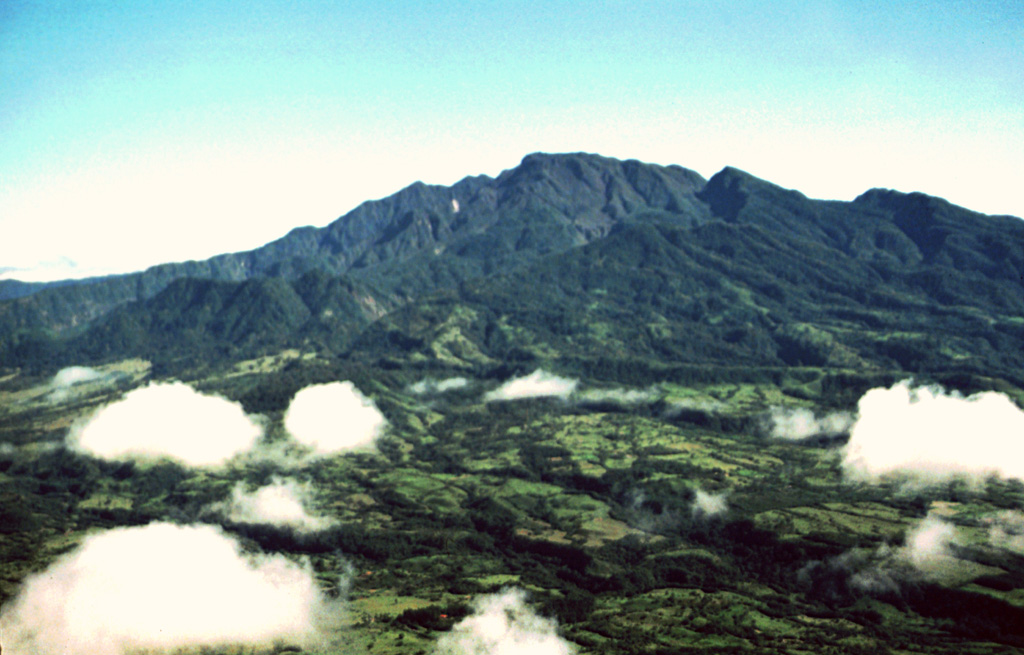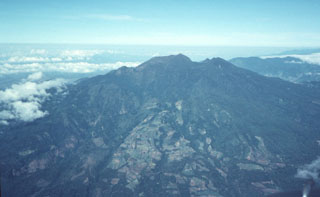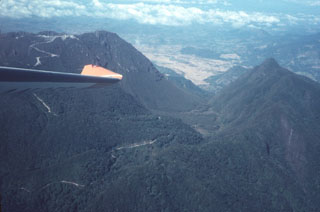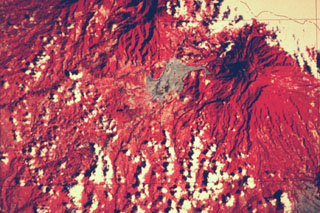

The Global Volcanism Program has no activity reports available for Barú.
The Global Volcanism Program has no Weekly Reports available for Barú.
The Global Volcanism Program has no Bulletin Reports available for Barú.
|
|
||||||||||||||||||||||||||||
There is data available for 8 confirmed eruptive periods.
1550 ± 10 years Confirmed Eruption (Explosive / Effusive)
| Episode 1 | Eruption (Explosive / Effusive) | ||||||||||||||||||||||||||||||||||
|---|---|---|---|---|---|---|---|---|---|---|---|---|---|---|---|---|---|---|---|---|---|---|---|---|---|---|---|---|---|---|---|---|---|---|
| 1550 ± 10 years - Unknown | Evidence from Observations: Reported | |||||||||||||||||||||||||||||||||
|
List of 5 Events for Episode 1
|
||||||||||||||||||||||||||||||||||
1340 ± 75 years Confirmed Eruption (Explosive / Effusive)
| Episode 1 | Eruption (Explosive / Effusive) | ||||||||||||||||||||||||
|---|---|---|---|---|---|---|---|---|---|---|---|---|---|---|---|---|---|---|---|---|---|---|---|---|
| 1340 ± 75 years - Unknown | Evidence from Correlation: Tephrochronology | |||||||||||||||||||||||
|
List of 3 Events for Episode 1
|
||||||||||||||||||||||||
1130 ± 150 years Confirmed Eruption (Explosive / Effusive)
| Episode 1 | Eruption (Explosive / Effusive) | |||||||||||||||||||||||||||||
|---|---|---|---|---|---|---|---|---|---|---|---|---|---|---|---|---|---|---|---|---|---|---|---|---|---|---|---|---|---|
| 1130 ± 150 years - Unknown | Evidence from Isotopic: 14C (calibrated) | ||||||||||||||||||||||||||||
|
List of 4 Events for Episode 1
|
|||||||||||||||||||||||||||||
0710 ± 30 years Confirmed Eruption (Explosive / Effusive)
| Episode 1 | Eruption (Explosive / Effusive) | ||||||||||||||||||||||||||||||||||||||||||||
|---|---|---|---|---|---|---|---|---|---|---|---|---|---|---|---|---|---|---|---|---|---|---|---|---|---|---|---|---|---|---|---|---|---|---|---|---|---|---|---|---|---|---|---|---|
| 0710 ± 30 years - Unknown | Evidence from Isotopic: 14C (calibrated) | |||||||||||||||||||||||||||||||||||||||||||
|
List of 7 Events for Episode 1
|
||||||||||||||||||||||||||||||||||||||||||||
0260 ± 150 years Confirmed Eruption (Explosive / Effusive)
| Episode 1 | Eruption (Explosive / Effusive) | |||||||||||||||||||
|---|---|---|---|---|---|---|---|---|---|---|---|---|---|---|---|---|---|---|---|
| 0260 ± 150 years - Unknown | Evidence from Isotopic: 14C (calibrated) | ||||||||||||||||||
|
List of 2 Events for Episode 1
|
|||||||||||||||||||
1270 BCE ± 100 years Confirmed Eruption (Explosive / Effusive)
| Episode 1 | Eruption (Explosive / Effusive) | |||||||||||||||||||
|---|---|---|---|---|---|---|---|---|---|---|---|---|---|---|---|---|---|---|---|
| 1270 BCE ± 100 years - Unknown | Evidence from Isotopic: 14C (calibrated) | ||||||||||||||||||
|
List of 2 Events for Episode 1
|
|||||||||||||||||||
7420 BCE ± 75 years Confirmed Eruption (Explosive / Effusive)
| Episode 1 | Eruption (Explosive / Effusive) | ||||||||||||||
|---|---|---|---|---|---|---|---|---|---|---|---|---|---|---|
| 7420 BCE ± 75 years - Unknown | Evidence from Isotopic: 14C (calibrated) | |||||||||||||
|
List of 1 Events for Episode 1
|
||||||||||||||
9280 BCE ± 30 years Confirmed Eruption (Explosive / Effusive)
| Episode 1 | Eruption (Explosive / Effusive) | ||||||||||||||
|---|---|---|---|---|---|---|---|---|---|---|---|---|---|---|
| 9280 BCE ± 30 years - Unknown | Evidence from Isotopic: 14C (calibrated) | |||||||||||||
|
List of 1 Events for Episode 1
|
||||||||||||||
This compilation of synonyms and subsidiary features may not be comprehensive. Features are organized into four major categories: Cones, Craters, Domes, and Thermal Features. Synonyms of features appear indented below the primary name. In some cases additional feature type, elevation, or location details are provided.
Synonyms |
| Chiriqui, Volcán de | Chirriqui |
 The Volcán Barú summit lava dome complex is seen here from the SE. The road to the right leads to communication towers at the summit. The ridge extending across the photo beyond the domes is the northern headwall of a large horseshoe-shaped collapse scarp.
The Volcán Barú summit lava dome complex is seen here from the SE. The road to the right leads to communication towers at the summit. The ridge extending across the photo beyond the domes is the northern headwall of a large horseshoe-shaped collapse scarp.  The summit of Barú volcano is just above the wing tip in this view from the SE. Communication towers line the ridge to the right of the summit. Behind it is the northern wall of a large horseshoe-shaped collapse scarp. The Pleistocene Volcán Colorado is under clouds to the upper right.
The summit of Barú volcano is just above the wing tip in this view from the SE. Communication towers line the ridge to the right of the summit. Behind it is the northern wall of a large horseshoe-shaped collapse scarp. The Pleistocene Volcán Colorado is under clouds to the upper right. This photo shows Volcán Barú from the ESE. The summit lava dome complex appears beyond the back wall of a large collapse scarp that forms an irregular ridge near the summit. The flat-topped edifice beyond Barú to the right (NW) is the Pleistocene Volcán Colorado.
This photo shows Volcán Barú from the ESE. The summit lava dome complex appears beyond the back wall of a large collapse scarp that forms an irregular ridge near the summit. The flat-topped edifice beyond Barú to the right (NW) is the Pleistocene Volcán Colorado.  The outer eastern flanks of the large Volcán Barú collapse scar are in the foreground, with the northern scarp forming the ridge to the right. The road to the left crosses over the scarp into its moat and then up to the top of a post-collapse lava dome complex that forms the summit.
The outer eastern flanks of the large Volcán Barú collapse scar are in the foreground, with the northern scarp forming the ridge to the right. The road to the left crosses over the scarp into its moat and then up to the top of a post-collapse lava dome complex that forms the summit. The Volcán Barú summit lava dome complex is seen in this view from the NE. The complex formed within a large 6 x 10 km horseshoe-shaped collapse scar, with its eastern scarp forming the ridge extending across the bottom of the photo. The peak to the far left is part of the southeastern scarp.
The Volcán Barú summit lava dome complex is seen in this view from the NE. The complex formed within a large 6 x 10 km horseshoe-shaped collapse scar, with its eastern scarp forming the ridge extending across the bottom of the photo. The peak to the far left is part of the southeastern scarp. The mottled color characteristic of debris avalanche deposits is visible in a roadcut near the town of Cuesta de Piedra, south of Volcán Barú along the road to Hato del Volcán. A massive debris avalanche deposit produced by flank collapse extends southward to beyond the Pan-American highway.
The mottled color characteristic of debris avalanche deposits is visible in a roadcut near the town of Cuesta de Piedra, south of Volcán Barú along the road to Hato del Volcán. A massive debris avalanche deposit produced by flank collapse extends southward to beyond the Pan-American highway. Las Lagunas, a group of small ponds west of Volcán Barú, formed between hummocks of a massive debris avalanche deposit that resulted from flank collapse. Las Lagunas is 5 km WSW of the town of Hato del Volcán and 19 km from the headwall of the collapse scarp where it originated.
Las Lagunas, a group of small ponds west of Volcán Barú, formed between hummocks of a massive debris avalanche deposit that resulted from flank collapse. Las Lagunas is 5 km WSW of the town of Hato del Volcán and 19 km from the headwall of the collapse scarp where it originated. The irregular hummocky terrain extending to the south toward the Pacific coastal plain is part of a massive debris avalanche deposit that originated from flank collapse of Volcán Barú. This view is from Cerro Pando, a lava dome to the west. At least two flank failure events have occurred, producing voluminous debris avalanche deposits that form a broad deposit reaching beyond the Pan-American highway to the Pacific coastal plain.
The irregular hummocky terrain extending to the south toward the Pacific coastal plain is part of a massive debris avalanche deposit that originated from flank collapse of Volcán Barú. This view is from Cerro Pando, a lava dome to the west. At least two flank failure events have occurred, producing voluminous debris avalanche deposits that form a broad deposit reaching beyond the Pan-American highway to the Pacific coastal plain. The northern area of the Volcán Barú collapse scarp is seen here from near the summit. The scarp at this point is about 300 m high, much of which has been filled in by a lava dome complex. The massive horseshoe-shaped collapse scar formed as a result of edifice collapse and is about 10 km long and 6 km wide.
The northern area of the Volcán Barú collapse scarp is seen here from near the summit. The scarp at this point is about 300 m high, much of which has been filled in by a lava dome complex. The massive horseshoe-shaped collapse scar formed as a result of edifice collapse and is about 10 km long and 6 km wide.  Some of the youngest lava domes of Volcán Barú are SW of the summit dome and rise about 80 m high. The summit of the SE-most dome (left) has a roughly 200-m-wide crater.
Some of the youngest lava domes of Volcán Barú are SW of the summit dome and rise about 80 m high. The summit of the SE-most dome (left) has a roughly 200-m-wide crater. The SE flanks of Volcán Barú are seen from the road to the town of Boquete, in western Panamá near the border with Costa Rica.
The SE flanks of Volcán Barú are seen from the road to the town of Boquete, in western Panamá near the border with Costa Rica.  Volcán Barú formed on the SW flanks of the Talamanca Range, which extends into Costa Rica. The SW flanks in this view are dominated by deposits produced by a massive flank failure event.
Volcán Barú formed on the SW flanks of the Talamanca Range, which extends into Costa Rica. The SW flanks in this view are dominated by deposits produced by a massive flank failure event.  This view is of the NW flank of Volcán Barú. The morphology of the edifice has funneled most eruption products (including pyroclastic flows, debris avalanches, and lahars) to the west and south, while the northern side of the volcano has been affected mostly by ashfall.
This view is of the NW flank of Volcán Barú. The morphology of the edifice has funneled most eruption products (including pyroclastic flows, debris avalanches, and lahars) to the west and south, while the northern side of the volcano has been affected mostly by ashfall. The lava dome complex in the center of this photo was the youngest feature of Volcán Barú when this photo was taken in 1998. It formed west of a remnant of an older lava dome seen on the horizon. The ridge on the left horizon is part of the NE wall of Barú's flank collapse scarp.
The lava dome complex in the center of this photo was the youngest feature of Volcán Barú when this photo was taken in 1998. It formed west of a remnant of an older lava dome seen on the horizon. The ridge on the left horizon is part of the NE wall of Barú's flank collapse scarp. The light brown area in the center of the photo is the surface of lake sediments deposited in a small former lake on Volcán Barú. The steep switchback dirt road leads from Boquete up the outer flanks towards the lake and then ascends the flanks of the dome complex towards the summit (upper left).
The light brown area in the center of the photo is the surface of lake sediments deposited in a small former lake on Volcán Barú. The steep switchback dirt road leads from Boquete up the outer flanks towards the lake and then ascends the flanks of the dome complex towards the summit (upper left). The SW flanks of Volcán Barú in the Talamanca Range of western Panama rise above agricultural lands at its base. A large 6-km-wide summit scarp opens towards the west (lower left) and is the result of a large flank collapse, which emplaced a massive debris avalanche deposit that underlies much of the farmlands in the foreground.
The SW flanks of Volcán Barú in the Talamanca Range of western Panama rise above agricultural lands at its base. A large 6-km-wide summit scarp opens towards the west (lower left) and is the result of a large flank collapse, which emplaced a massive debris avalanche deposit that underlies much of the farmlands in the foreground. This false-color Landsat image shows two large Quaternary volcanoes in western Panamá. Barú volcano is at the upper right below the cloud cover, and Volcán Colorado lies at the top center. Virtually the entire lower left quadrant of the image is underlain by debris avalanche deposits produced by collapse of these two volcanoes, which left large scarps opening widely towards the W and SW. The light-colored area west of Barú consists of pyroclastic flow and lahar deposits related to lava dome growth.
This false-color Landsat image shows two large Quaternary volcanoes in western Panamá. Barú volcano is at the upper right below the cloud cover, and Volcán Colorado lies at the top center. Virtually the entire lower left quadrant of the image is underlain by debris avalanche deposits produced by collapse of these two volcanoes, which left large scarps opening widely towards the W and SW. The light-colored area west of Barú consists of pyroclastic flow and lahar deposits related to lava dome growth. The large flank collapse scar of Volcán Barú is seen here from the west, with its northern wall extending downward left of the summit. The summit itself is a large lava dome complex constructed within the scarp near its eastern headwall. The vegetated horizontal N-S-trending ridge below and to the right of the summit dome complex are segments of the former edifice that slid down intact. The towns of Nuevo California and Hato del Volcán are at the base of the volcano to the right.
The large flank collapse scar of Volcán Barú is seen here from the west, with its northern wall extending downward left of the summit. The summit itself is a large lava dome complex constructed within the scarp near its eastern headwall. The vegetated horizontal N-S-trending ridge below and to the right of the summit dome complex are segments of the former edifice that slid down intact. The towns of Nuevo California and Hato del Volcán are at the base of the volcano to the right. The 10-km-long northern wall of Volcán Barú's horseshoe-shaped collapse scarp extends from the grassy ridge at the lower left to the peak to the upper left. In the center is the large lava dome complex that has filled much of the scar. The light-colored valley floor of Río Macho de Monte in the foreground is composed of pyroclastic flow deposits related to growth and collapse of the summit lava domes. The town of Nuevo Bambito is visible at the bottom of the photo.
The 10-km-long northern wall of Volcán Barú's horseshoe-shaped collapse scarp extends from the grassy ridge at the lower left to the peak to the upper left. In the center is the large lava dome complex that has filled much of the scar. The light-colored valley floor of Río Macho de Monte in the foreground is composed of pyroclastic flow deposits related to growth and collapse of the summit lava domes. The town of Nuevo Bambito is visible at the bottom of the photo.There are no samples for Barú in the Smithsonian's NMNH Department of Mineral Sciences Rock and Ore collection.
| Copernicus Browser | The Copernicus Browser replaced the Sentinel Hub Playground browser in 2023, to provide access to Earth observation archives from the Copernicus Data Space Ecosystem, the main distribution platform for data from the EU Copernicus missions. |
| MIROVA | Middle InfraRed Observation of Volcanic Activity (MIROVA) is a near real time volcanic hot-spot detection system based on the analysis of MODIS (Moderate Resolution Imaging Spectroradiometer) data. In particular, MIROVA uses the Middle InfraRed Radiation (MIR), measured over target volcanoes, in order to detect, locate and measure the heat radiation sourced from volcanic activity. |
| MODVOLC Thermal Alerts | Using infrared satellite Moderate Resolution Imaging Spectroradiometer (MODIS) data, scientists at the Hawai'i Institute of Geophysics and Planetology, University of Hawai'i, developed an automated system called MODVOLC to map thermal hot-spots in near real time. For each MODIS image, the algorithm automatically scans each 1 km pixel within it to check for high-temperature hot-spots. When one is found the date, time, location, and intensity are recorded. MODIS looks at every square km of the Earth every 48 hours, once during the day and once during the night, and the presence of two MODIS sensors in space allows at least four hot-spot observations every two days. Each day updated global maps are compiled to display the locations of all hot spots detected in the previous 24 hours. There is a drop-down list with volcano names which allow users to 'zoom-in' and examine the distribution of hot-spots at a variety of spatial scales. |
|
WOVOdat
Single Volcano View Temporal Evolution of Unrest Side by Side Volcanoes |
WOVOdat is a database of volcanic unrest; instrumentally and visually recorded changes in seismicity, ground deformation, gas emission, and other parameters from their normal baselines. It is sponsored by the World Organization of Volcano Observatories (WOVO) and presently hosted at the Earth Observatory of Singapore.
GVMID Data on Volcano Monitoring Infrastructure The Global Volcano Monitoring Infrastructure Database GVMID, is aimed at documenting and improving capabilities of volcano monitoring from the ground and space. GVMID should provide a snapshot and baseline view of the techniques and instrumentation that are in place at various volcanoes, which can be use by volcano observatories as reference to setup new monitoring system or improving networks at a specific volcano. These data will allow identification of what monitoring gaps exist, which can be then targeted by remote sensing infrastructure and future instrument deployments. |
| Volcanic Hazard Maps | The IAVCEI Commission on Volcanic Hazards and Risk has a Volcanic Hazard Maps database designed to serve as a resource for hazard mappers (or other interested parties) to explore how common issues in hazard map development have been addressed at different volcanoes, in different countries, for different hazards, and for different intended audiences. In addition to the comprehensive, searchable Volcanic Hazard Maps Database, this website contains information about diversity of volcanic hazard maps, illustrated using examples from the database. This site is for educational purposes related to volcanic hazard maps. Hazard maps found on this website should not be used for emergency purposes. For the most recent, official hazard map for a particular volcano, please seek out the proper institutional authorities on the matter. |
| IRIS seismic stations/networks | Incorporated Research Institutions for Seismology (IRIS) Data Services map showing the location of seismic stations from all available networks (permanent or temporary) within a radius of 0.18° (about 20 km at mid-latitudes) from the given location of Barú. Users can customize a variety of filters and options in the left panel. Note that if there are no stations are known the map will default to show the entire world with a "No data matched request" error notice. |
| UNAVCO GPS/GNSS stations | Geodetic Data Services map from UNAVCO showing the location of GPS/GNSS stations from all available networks (permanent or temporary) within a radius of 20 km from the given location of Barú. Users can customize the data search based on station or network names, location, and time window. Requires Adobe Flash Player. |
| DECADE Data | The DECADE portal, still in the developmental stage, serves as an example of the proposed interoperability between The Smithsonian Institution's Global Volcanism Program, the Mapping Gas Emissions (MaGa) Database, and the EarthChem Geochemical Portal. The Deep Earth Carbon Degassing (DECADE) initiative seeks to use new and established technologies to determine accurate global fluxes of volcanic CO2 to the atmosphere, but installing CO2 monitoring networks on 20 of the world's 150 most actively degassing volcanoes. The group uses related laboratory-based studies (direct gas sampling and analysis, melt inclusions) to provide new data for direct degassing of deep earth carbon to the atmosphere. |
| Large Eruptions of Barú | Information about large Quaternary eruptions (VEI >= 4) is cataloged in the Large Magnitude Explosive Volcanic Eruptions (LaMEVE) database of the Volcano Global Risk Identification and Analysis Project (VOGRIPA). |
| EarthChem | EarthChem develops and maintains databases, software, and services that support the preservation, discovery, access and analysis of geochemical data, and facilitate their integration with the broad array of other available earth science parameters. EarthChem is operated by a joint team of disciplinary scientists, data scientists, data managers and information technology developers who are part of the NSF-funded data facility Integrated Earth Data Applications (IEDA). IEDA is a collaborative effort of EarthChem and the Marine Geoscience Data System (MGDS). |